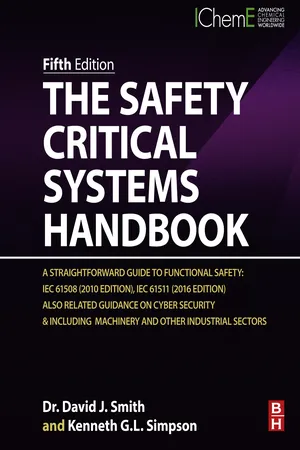
The Safety Critical Systems Handbook
A Straightforward Guide to Functional Safety: IEC 61508 (2010 Edition), IEC 61511 (2015 Edition) and Related Guidance
- 360 pages
- English
- ePUB (mobile friendly)
- Available on iOS & Android
The Safety Critical Systems Handbook
A Straightforward Guide to Functional Safety: IEC 61508 (2010 Edition), IEC 61511 (2015 Edition) and Related Guidance
About this book
The Safety Critical Systems Handbook: A Straightforward Guide to Functional Safety: IEC 61508 (2010 Edition), IEC 61511 (2015 Edition) and Related Guidance, Fifth Edition presents the latest guidance on safety-related systems that guard workers and the public against injury and death, also discussing environmental risks. This comprehensive resource has been fully revised, with additional material on risk assessment, cybersecurity, COMAH and HAZID, published guidance documents/standards, quantified risk assessment and new worked examples. The book provides a comprehensive guide to the revised IEC 61508 standard as well as the 2016 IEC 61511.This book will have a wide readership, not only in the chemical and process industries, but in oil and gas, power generation, avionics, automotive, manufacturing and other sectors. It is aimed at most engineers, including those in project, control and instrumentation, design and maintenance disciplines.- Provides the only comprehensive guide to IEC 61508 and 61511 (updated for 2016) that ensures engineers are compliant with the latest process safety systems design and operation standards- Presents a real-world approach that helps users interpret the standard, with new case studies and best practice design examples using revised standards- Covers applications of the standard to device design
Frequently asked questions
- Essential is ideal for learners and professionals who enjoy exploring a wide range of subjects. Access the Essential Library with 800,000+ trusted titles and best-sellers across business, personal growth, and the humanities. Includes unlimited reading time and Standard Read Aloud voice.
- Complete: Perfect for advanced learners and researchers needing full, unrestricted access. Unlock 1.4M+ books across hundreds of subjects, including academic and specialized titles. The Complete Plan also includes advanced features like Premium Read Aloud and Research Assistant.
Please note we cannot support devices running on iOS 13 and Android 7 or earlier. Learn more about using the app.
Information
Functional Safety Management
Template Procedure
Company Standard xxx Implementation of Functional Safety
Contents
- 1. Purpose of Document
- 2. Scope
- 3. Functional Safety Policy
- 4. Quality and Safety Plan
- 5. Competencies
- 6. Review of Requirement and Responsibilities
-
- 6.1 Source of the requirement
- 6.1 Contract or project review
- 6.1 Assigning responsibilities
- 7. Functional Safety Specification
- 8. Life-Cycle Activities
-
- 8.1 Integrity Targeting
- 8.2 Random Hardware Failures
- 8.3 ALARP
- 8.4 Architectures
- 8.5 Life-cycle activities
- 8.6 Functional Safety Capability
- 9. Implementation
- 10. Validation
-
- Work Instruction xxx/001—Random Hardware Failures & ALARP
- Work Instruction xxx/002—Integrity Targeting
- Work Instruction xxx/003—Life-Cycle Activities
- Work Instruction xxx/004—Architectures (SFF)
- Work Instruction xxx/005—Rigour of Life-Cycle Activities
- Work Instruction xxx/006—Functional Safety Competence
- Work Instruction xxx/007—Functional Safety Plan
- Work Instruction xxx/008—Functional Safety Specification
1. Purpose of Document
2. Scope

3. Functional Safety Policy
4. Quality and Safety Plan
5. Competencies
- Individuals' attendance at relevant off-the-job courses
- Records of safety-related experience from each project (on-the-job training) (Project Managers will provide this information to the Personnel Manager)
- Details ...
Table of contents
- Cover image
- Title page
- Table of Contents
- Copyright
- A Quick Overview
- The 2010 Version of IEC 61508
- The 2016 Version of IEC 61511
- Acknowledgments
- Part A. The Concept of Safety Integrity
- Part B. Specific Industry Sectors
- Part C. Case Studies in the Form of Exercises and Examples
- Appendix 1. Functional Safety Management
- Appendix 2. Assessment Schedule
- Appendix 3. BETAPLUS CCF Model, Scoring Criteria
- Appendix 4. Assessing Safe Failure Fraction and Diagnostic Coverage
- Appendix 5. Answers to Examples
- Appendix 6. References
- Appendix 7. Quality and Safety Plan
- Appendix 8. Some Terms and Jargon of IEC 61508
- Appendix 9. Control of Major Accident Hazards (COMAH)
- Back Matter
- Appendices
- The Technis Reliability & Functional Safety Standard Guidelines
- Index